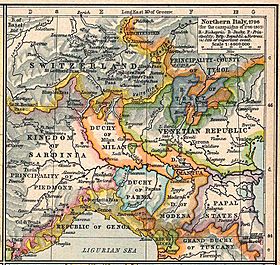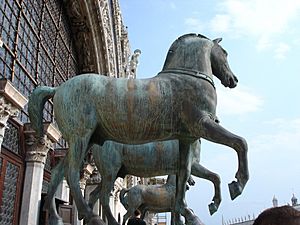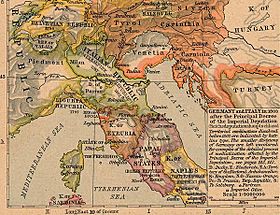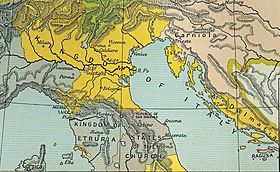Fall of the Republic of Venice facts for kids
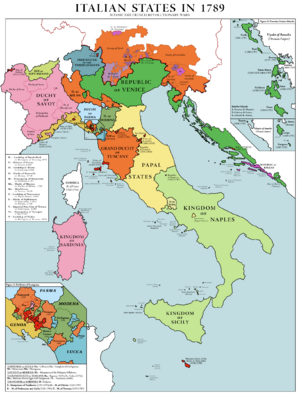
The fall of the Republic of Venice was a series of events that ended on May 12, 1797. This led to the old Republic of Venice being broken up by Napoleon Bonaparte and Austria.
In 1796, a young general named Napoleon was sent by the new French Republic to fight Austria. He chose to go through Venice, which was officially neutral. The Venetians reluctantly let the powerful French army enter their country. This was so the French could fight Austria.
However, the French secretly started helping revolutionaries inside Venice. The Venetian government began quietly getting ready for war. Venice's army was weak. It was no match for the experienced French soldiers or even a local uprising.
After the capture of Mantua in February 1797, the French openly called for revolution in Venice's lands. By March 13, there was open rebellion. Cities like Brescia and Bergamo broke away. But many people still supported Venice. France had to show its true goals when it sent military help to the struggling revolutionaries.
On April 25, Napoleon openly threatened war on Venice. He said Venice must become a democracy. The Venetian Senate agreed to many demands. But facing more rebellions and the threat of invasion, it gave up power. A temporary government of revolutionaries (who supported the French) took over. On May 12, Ludovico Manin, the last leader (called a doge) of Venice, officially ended the Republic of Venice. It had existed for 1,100 years.
The French and Austrians had secretly agreed on April 17 in the Treaty of Leoben. France would give Venice to Austria. In return, France would get Austria's lands in the Netherlands. France let the people vote on accepting the treaty terms. On October 28, Venice voted to accept the terms. They preferred Austria to France.
This preference was smart. The French then thoroughly looted Venice. They stole or sank the entire Venetian Navy. They also destroyed much of the Venetian Arsenal. This was a sad end for what was once one of Europe's strongest navies.
On January 18, 1798, the Austrians took control of Venice. They stopped the looting. But Austria's control did not last long. Venice returned to French control by 1805. It then went back to Austrian hands in 1815. It became part of the Kingdom of Lombardy–Venetia. Finally, it joined the Kingdom of Italy in 1866.
Contents
How the Conflict Started
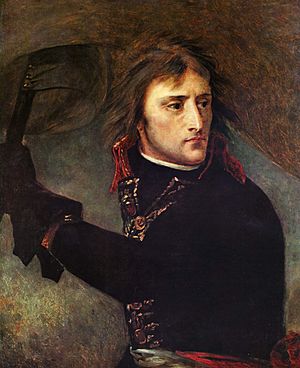
The fall of Venice happened because of events after the French Revolution in 1789. The French Revolutionary Wars began. The First French Republic fought against the kings and queens of Europe. These rulers joined together in the First Coalition in 1792. This happened especially after King Louis XVI of France was executed in 1793. This made European monarchies unite against Revolutionary France.
In 1794, the French prince Louis Stanislas Xavier (who would later be King Louis XVIII) stayed in Verona. He was a guest of Venice. France protested strongly, so Venice told Louis to leave. He left Verona on April 21. As a protest, the prince asked for his name to be removed from the libro d'oro (a list of Venetian nobles). He also asked for the armor of Henry IV of France to be returned. Venice's actions also upset other European courts.
In 1795, France ended the violent Reign of Terror. A more conservative government, the Directory, took over. In 1796, the Directory planned a big attack against the First Coalition. The main attack was in Germany. A smaller attack was in northern Italy against the Austrians. The Italian campaign was given to the young general Napoleon Bonaparte. He was 27 years old. In April 1796, he crossed the Alps with 45,000 men. He went to fight the Austrians and the Piemontese.
Napoleon quickly defeated Sardinia. Then he moved into the Duchy of Milan, which Austria controlled. On May 9, the Austrian governor of Milan, Archduke Ferdinand, left for Bergamo in Venetian territory. Six days later, after winning the Battle of Lodi, Napoleon entered Milan. He forced King Victor Amadeus III of Sardinia to sign a harsh peace treaty. The Austrian forces went to defend the Bishopric of Trent. On May 17, the Duchy of Modena also made a truce with the French.
During this time, Venice stayed neutral, as was its custom. But its lands in northern Italy were now in the path of the French army. So, on May 20, the French ended their truce and started fighting again.
French Troops Enter Venetian Lands
French Arrival in Lombardy
As the French army approached, the Venetian Senate acted. On May 12, 1796, they created a special official for their mainland territories. This official would oversee all local leaders. However, Venice's defenses were very weak. They lacked weapons, and their forts were falling apart.
Venetian Lombardy was soon filled with refugees fleeing the war. Broken or fleeing Austrian troops also arrived. Soon, French soldiers began to sneak in. Venetian officials struggled to stop both Austrian and French troops from passing through Crema.
Napoleon himself arrived outside Crema. He offered an alliance with Venice, but Venice did not reply. Because of its weak defenses, Venice offered little resistance to the retreating Austrians. But they firmly refused Austria's requests for food and supplies.
Soon, the situation was critical for Venice. Not only Lombardy, but even Veneto was threatened. First, the Austrian commander, Jean-Pierre de Beaulieu, took Peschiera del Garda by trickery. Then, on May 29, the French army entered Desenzano del Garda. On the night of May 29/30, Napoleon crossed the Mincio River with many troops. This forced the Austrians to retreat to Tyrol.
Venice complained about the damage caused by French troops. Napoleon replied by threatening to burn Verona and march on Venice itself. He claimed Venice favored France's enemies by not declaring war after the events at Peschiera. He also said Venice was hiding the French prince Louis.
Opening Borders to Napoleon's Troops
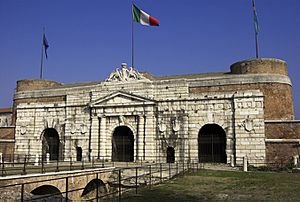
On June 1, to avoid angering Napoleon, Venice allowed French troops into Verona. Venetian lands officially became a battlefield. In many cities, French occupation created problems between French soldiers, Venetian military, and local people.
Facing danger, the Senate ordered the Venetian fleet to return. They also called up the local militia in Istria. A new official was created to defend the Venetian Lagoon and Lido. This was to protect the heart of Venice. New taxes were raised, and people were asked for donations to rearm the state.
Venice's ambassador in Paris was told to protest to the French government about breaking neutrality. At the same time, Venetian diplomats in Vienna complained about Austrian forces bringing war to their lands.
On June 5, the Kingdom of Naples signed a truce with Napoleon. On June 10, the heir to the Duchy of Parma did the same. Two days later, Napoleon invaded Romagna, which belonged to the Papal States. On June 23, the Pope had to accept French occupation of northern lands. This allowed the French to take the port city of Ancona on the Adriatic Sea.
French warships in the Adriatic made Venice renew an old rule. This rule banned foreign fleets from entering the Venetian Lagoon. Venice told Paris about this. Small fleets and forts were set up along the lagoon's shores. This was to block access from land and sea. On July 5, an official wrote that it was sad to see Venice only thinking about defending its main waterways.
Venice seemed to have lost its mainland forever, like during the War of the League of Cambrai. The government decided to use its forces to prevent this. Venice prepared to mobilize its army and give command to William of Nassau. But they stopped at the last moment due to opposition from both Austrians and French.
By mid-July, French troops were in Crema, Brescia, and Bergamo. This separated French and Austrian forces, who had made a truce. At the same time, diplomats tried to get Venice to join an alliance with France and the Ottoman Empire against Russia. However, news of an Austrian counterattack from Tyrol made Venice officially reject France's offers on July 22.
Meanwhile, a new special official, Francesco Battagia, was appointed. He practically replaced the previous official. In Venice, night patrols of shopkeepers and workers were formed. They were led by nobles and citizens to keep order. In Bergamo, troops were quietly recruited in nearby valleys. They avoided conflict with the French occupiers.
On July 31, Napoleon occupied Brescia Castle.
Austrian Attack Fails
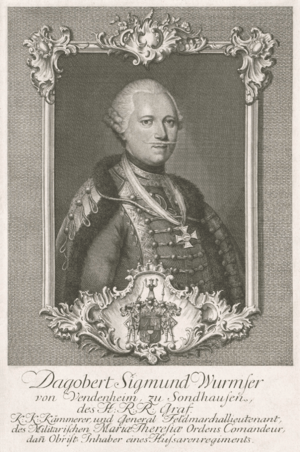

On July 29, the Austrians under Wurmser began their attack. They came from Tyrol in two groups. They advanced along Lake Garda and the Brenta River, passing through Venetian lands. The two Austrian groups were stopped at Lonato del Garda on August 3 and Castiglione delle Stiviere on August 5. Defeated, Wurmser had to return to Trent.
After regrouping, Wurmser attacked again. He advanced along the Adige river. But on September 8, at the Battle of Bassano, the Austrians were heavily defeated. They had to flee quickly to Mantua, leaving their artillery and supplies.
As a result, during autumn and winter, the French strengthened their control in Italy. On October 15/16, they created the Cispadane Republic and the Transpadane Republic. These were states controlled by France. At the same time, in Venice's mainland, French soldiers gradually took over Venetian defenses. They took control of cities and forts.
The Venetian government continued to tell its officials to cooperate with the French. They wanted to avoid any reason for conflict. But the French more openly began to support local revolutionaries.
On October 29, the Austrians, gathered in Venetian Friuli, tried a new attack. They crossed the Tagliamento river. Then they crossed the Piave on November 2. They reached Brenta on November 4. The Austrians pushed the French back in the Second Battle of Bassano on November 6. They entered Vicenza. However, the battles of Caldiero (November 12) and especially Arcole (November 15–17) stopped the Austrian advance. Finally, in the Battle of Rivoli on January 14–15, 1797, Napoleon decisively defeated the Austrians. This restored French power.
Revolts in Bergamo and Brescia

With the capture of Mantua on February 2, 1797, the French removed the last Austrian resistance in Italy. The French now openly pushed for "democracy" in Bergamo. Under pressure from General Louis Baraguey d'Hilliers, Bergamo revolted against Venice on March 13. It established the Republic of Bergamo.
Three days later, the Venetian official Francesco Battagia tried to restore order. He offered a general pardon for any acts disturbing public order. However, Battagia already feared losing Brescia, where he was staying. The revolutionaries from Bergamo were marching towards Brescia.
On March 16, at the Battle of Valvasone, Napoleon defeated Archduke Charles. This opened the way to Austria. The next day, the Venetian Senate thanked the towns and forts loyal to the Republic. For the first time, they ordered them to take defensive actions. They ordered the Lagoon of Venice to be barricaded. Armed patrols were set up in the city's core. Naval units from overseas were called back. The Arsenal of Venice, the military heart of the state, was told to increase production. Troops were to be sent from overseas lands to the mainland.
On March 19, the state inquisitors reported on the condition of the local governments. For Bergamo, which was in rebellion, no information was available. The inquisitors waited for news from nearby forts and valleys. The situation in Brescia was still calm and under Battagia's control. Crema also needed its garrison reinforced. An anti-French mood was strong in Verona. Padua and Treviso were quiet, but Venice watched Padua closely because of its university students.
However, the inquisitors did not know that in Brescia the day before (March 18), a group of important people had started a revolt. They wanted to be free from Venetian rule. They only had support from Bergamo and the French, who controlled the city's fort. But Battagia decided to leave the city with his troops. He did not want to endanger the people, who were mostly still pro-Venetian.
News of this reached Venice only on March 20, after Battagia arrived in Verona. The government seemed to react to the news. A letter from the Doge was sent to all local governments. It ordered "absolute defense" and demanded new oaths of loyalty to the Republic. On March 21, while Bonaparte entered Gradisca, the first reply came: Treviso declared itself fully loyal to Venice.
The next day, however, a letter from Udine arrived. Venetian ambassadors who had met Napoleon said he was acting more evasive and suspicious. The government decided to tell the main officials in the mainland, who were gathered in Verona, to be very careful with the French. This meant replacing "absolute defense" with the hope of not giving Napoleon a reason for open conflict.
On March 24, new pledges of loyalty came from Vicenza and Padua. Soon after, Verona, Bassano, Rovigo, and other centers followed. Many groups even came from the valleys of Bergamo, ready to rise against the French.
On March 25, however, the Lombard revolutionaries occupied Salò. On March 27, they took Crema. The next day, they declared the Republic of Crema. French involvement became bolder. French cavalry suppressed resistance in Crema. Then, on March 31, French artillery bombarded Salò, which had rebelled against the revolutionaries.
Venice's Counterattack
These events finally made Venetian officials on the mainland allow a partial call-up of the militia. They also prepared Verona, their main military base, for defense. The French occupiers initially pretended not to interfere. They allowed Venetian forces to retake control of cities in Venetian Lombardy. This is shown by an agreement signed on April 1. Venice agreed to pay Napoleon one million lire per month to fund his campaign against Austria. Venice hoped this would quickly end the conflict and make the French troops leave. This would also give them freedom to act against the Lombard revolutionaries.
But as popular uprisings for Venice spread and Venetian forces advanced, the French had to help the Lombard revolutionaries. This showed their true intentions. On April 6, a Venetian cavalry officer was arrested for treason by the French and taken to Brescia. On April 8, the Senate learned that revolutionaries from Brescia, wearing French uniforms, had raided up to the gates of Legnano. The next day, a statement called the people of the mainland to abandon Venice. Venice had only cared about its capital's safety until then.
At the same time, the French general Jean-Andoche Junot received a letter from Napoleon. Napoleon complained about the anti-French uprising on the mainland. On April 10, after the French captured a Venetian ship with weapons in Lake Garda, they accused Venice of breaking its neutrality. They said Venice had started anti-revolutionary revolts among the people of Brescia and Bergamo. General Sextius Alexandre François de Miollis complained about attacks on a group of Polish volunteers. On April 12, because of more French warships, Venice ordered all its ports to be very watchful.
Finally, on April 15, Napoleon's ambassador in Venice told the Signoria of Venice that France intended to support revolts against Venice's "tyrannical government." The Venetian government responded with a statement urging its people to stay calm and respect the state's neutrality.
Leoben and the "Veronese Easter"
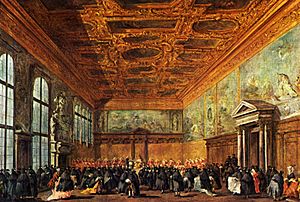
On April 17, 1797, Napoleon signed a preliminary truce at Leoben in Styria. This was with representatives of the Austrian Emperor, Francis II. In secret parts of the treaty, Venice's mainland territories were already given to Austria. In return, France would get Austria's lands in the Netherlands.
On the same day, events quickly unfolded in Verona. The people, and some Venetian troops there, were tired of French arrogance. They rose in revolt. This event, known as the "Veronese Easter", quickly put the French occupation troops on the defensive. They were forced into the city's forts.
On April 20, even though foreign warships were banned from the Venetian Lagoon, the French frigate Le Libérateur d'Italie (meaning "Italy's Liberator") tried to enter the Lagoon. The artillery on the Fort of Sant'Andrea opened fire. It sank the ship and killed its captain.
However, the Venetian government still hesitated. They hoped to avoid open conflict, even if it meant losing their mainland lands. They refused to mobilize the army or send help to Verona. Verona was forced to surrender on April 24.
On April 25, Venice's patron saint's day, Napoleon openly threatened war on Venice at Graz. He boasted he had 80,000 men and twenty gunships ready to overthrow the Republic. Napoleon also accused Venice of refusing an alliance with France. He said Venice only wanted to keep its army ready to block the French retreat if they were defeated.
In the next few days, the French army fully occupied the mainland, reaching the shores of the Venetian Lagoon. On April 30, a letter from Napoleon, who was now at Palmanova, told Venice that he intended to change their government. But he offered to keep its basic structure. This ultimatum would expire in four days.
The Venetian government tried to make peace. On May 1, they told Napoleon they would reform their government to be more democratic. But on May 2, the French declared war on Venice.
On May 3, Venice canceled the general call-up for its militia in Dalmatia. Then, in another attempt to calm Napoleon, on May 4, the Great Council of Venice voted to accept French demands. This included arresting the fort commander and three state inquisitors. The inquisitors were especially disliked by the revolutionaries because they protected Venice's noble-led government.
On May 8, the Doge, Ludovico Manin, said he was ready to give up his symbols of power to the revolutionary leaders. He asked all officials to do the same. This was even though a ducal advisor urged him to flee to Zara in Dalmatia, which was still safely in Venetian hands. Venice still had a fleet and loyal lands in Istria and Dalmatia. The city's defenses were also intact. However, the nobles were terrified of a popular uprising. So, they ordered even the loyal Balkan troops in the city to be sent home. The advisor himself was forced to escape the city after the government ordered his arrest to please Napoleon.
May 12, 1797: Venice Falls
On the morning of May 12, amidst rumors of plots and an upcoming French attack, the Great Council met for the last time.
The council then looked at the French demands. These were brought by some Venetian revolutionaries. The demands included the government stepping down for a temporary city council, putting a "tree of liberty" in St Mark's Square, French soldiers landing, and handing over officials who had supported resistance.
During the meeting, the assembly panicked. They heard gunshots from St Mark's Square. The Balkan troops had fired their muskets to salute the Banner of Saint Mark before getting on a ship. But the terrified nobles thought it meant a popular revolt. The vote was taken immediately. With 512 votes for, 5 abstentions, and 20 against, the Republic was declared abolished.
As the assembly quickly left, the Doge and officials removed their symbols of power. They went to the balcony of the Ducal Palace to announce the decision to the crowd below. At the end of the announcement, the crowd cheered. But it was not for revolution, as the nobles feared. They shouted Viva San Marco! (Long Live St. Mark!) and Viva la Repubblica! (Long Live the Republic!). The crowd raised the Flag of St. Mark on the three poles in the square. They tried to bring back the Doge. They attacked the homes and property of Venetian revolutionaries. The officials, afraid of facing the French, tried to calm the crowd. Patrols of men from the Arsenal and artillery shots at Rialto restored order in the city.
French Take Over Venice
Last Actions of the Doge

On the morning of May 13, still in the name of the "Most Serene Prince" (the Doge), and with the usual Saint Mark coat of arms, three announcements were made. They threatened death to anyone who dared to revolt. They ordered stolen valuables to be returned. Finally, they recognized the revolutionary leaders as heroes of the homeland.
The next day was the last deadline for the truce Napoleon had given. After that, the French would force their way into the city. So, it was agreed to send them the necessary boats to carry 4,000 men. Of these, 1,200 were for Venice and the rest for the surrounding islands and forts.
On May 15, the Doge left the Ducal Palace forever. He retired to his family's home. In the old government's last order, he announced the birth of the Provisional Municipality of Venice.
New Government in Venice
The Provisional Municipality set up its office in the Ducal Palace. This was in the same hall where the Great Council used to meet.
On the same day, a peace treaty was signed in Milan. As requested by the Municipality, French troops entered the city. These were the first foreign troops to set foot in Venice in a thousand years.
At the same time, the provinces began to rebel against the new Municipality of Venice. They wanted to set up their own governments. The public debt grew, as there was no income from its former lands. Banks stopped paying out money. These and other money problems made some people very unhappy. On June 4, in St Mark's Square, the "Tree of Liberty" was raised. During the ceremony, the Republic's flag was cut into pieces. The nobles' libro d'oro (golden book) was burned. A new symbol was shown: a winged lion with the words "RIGHTS OF MAN AND OF THE CITIZEN."
A month later, on July 11, the Ghetto of Venice was abolished. The city's Jewish people were given freedom to move around.
Loss of Overseas Lands
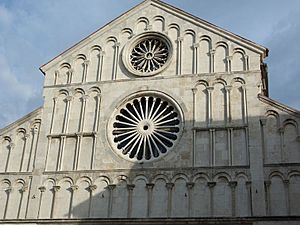
On June 13, the French feared the new Municipality could not control Corfu. So, a French fleet sailed from Venice. Their goal was to remove the Venetian official in Corfu, Carlo Aurelio Widmann, who still controlled Venice's overseas lands. They wanted to set up a democratic government. So, on June 27, the Provisional Municipality of the Ionian Islands was created.
Meanwhile, in Istria, Dalmatia, and Venetian Albania, Venetian officials and local nobles refused to recognize the new government. The fleet that had taken the Balkan troops home stayed there. It showed no intention of returning to Venice or making the Municipality's control stick. In Traù, the property of pro-revolutionaries was looted. In Sebenico (now Šibenik, Croatia), the French consul was killed.
News about the secret terms agreed at Leoben spread. This made people push for a quick Austrian takeover. On July 1, the Austrians entered Zara. They were greeted with ringing bells and artillery shots. The flags of the Republic, which had been flying, were taken in a procession to the cathedral. There, the people honored them. In Perasto (in modern-day Montenegro), the last Venetian settlement to surrender, the flag was symbolically buried under the main altar on August 23. The entire Istro-Dalmatian coast then went to Austrian hands. The Provisional Municipality of Venice protested, but it was useless.
"Terror" in Venice
On July 22, a Committee of Public Safety, set up by the Provisional Municipality of Venice, created a Criminal Council. This council began to stop political disagreement. It ordered the death penalty for anyone who shouted Viva San Marco!. Moving around without a pass was forbidden. On October 12, the Municipality announced they had found a plot against them. This led the French general Antoine Balland, the city's military governor, to declare a state of siege. He then arrested and imprisoned hostages.
Treaty of Campoformio: Venice's End
Austria and France Make a Deal
After the Coup of 18 Fructidor on September 4, 1797, strong supporters of the Republic took control in France. They wanted to restart fighting with Austria. On September 29, Napoleon was ordered to cancel the Leoben agreement. He was told to give Austria an ultimatum, leaving them no chance to retake Italy. However, the general ignored these orders. He continued peace talks with Austria.
Meanwhile, the political situation was getting worse. The cities of the mainland agreed to meet in Venice. They wanted to decide the future of Venice's former lands. They decided to join the newly formed Cisalpine Republic. But the French did not follow the people's choice.
The last meeting between French and Austrians happened on October 16. It was at the villa of the former Doge Ludovico Manin. On October 17, the Treaty of Campoformio was signed. According to the secret parts of the Leoben treaty, Venice's lands were given to the Austrian empire. The Provisional Municipality and all other revolutionary governments set up by the French ceased to exist.
On October 28, in Venice, people were asked to vote. They could accept the French decisions or resist them. Out of 23,568 votes, 10,843 were for submitting. While the leaders of the Provisional Municipality tried to resist, sending envoys to Paris, Austrian agents and the deposed nobles had already prepared for Austrian occupation. The Provisional Municipality's envoys were arrested in Milan and sent home.
Venice Looted and Handed Over
On November 21, during the traditional Festa della Salute, the Municipality's representatives were publicly criticized by the people. They gave up power. The French occupiers then began widespread looting.
Of the 184 ships in the Arsenal, those ready were sent to Toulon. The rest were sunk. This ended the Venetian navy. To prevent Austria from getting any benefits, the fleet's storage areas were plundered. The two thousand Arsenal workers were fired. The entire complex was burned down.
Churches, convents, and many palaces were emptied of valuables and artworks. The state mint and the treasury of Saint Mark's Church were taken. The Doge's ceremonial ship, the Bucintoro, had all its sculptures removed. These were burned on the island of San Giorgio Maggiore to get their gold leaf. Even the bronze Horses of Saint Mark were taken to Paris. Private citizens were imprisoned and forced to hand over their wealth for freedom.
On December 28, the French military and a police committee took power. Austrian troops entered the city on January 18, 1798.
What Happened Next
Austrian rule did not last long. On March 18, 1805, the Treaty of Pressburg gave Austria's Venetian lands to France. On May 26, Napoleon, who had become Emperor of the French, was crowned King of Italy in Milan.
Venice returned to French control. Napoleon closed religious groups and started big public works. Venice was to become one of his empire's capitals. In St Mark's Square, a new wing was built for Napoleon's royal residence. A new avenue was opened in the city, named after Napoleon's stepson.
In 1807, the head priest of St Mark's was removed. The basilica became the main church of Venice. In 1808, Dalmatia was also added to Napoleon's Kingdom of Italy. It was later directly controlled by France as the Illyrian Provinces in 1809.
The second period of French rule ended when Napoleon fell in the War of the Sixth Coalition. On April 20, 1814, Venice returned to Austrian rule. With the collapse of the Kingdom of Italy, the entire Veneto region followed. The region became part of the Kingdom of Lombardy–Venetia in 1815.
Venice was the only major state destroyed by the French Revolution that was not restored after Napoleon's defeat.
Legacy
The shock of Venice's fall, especially its handover to Austria, is shown in the novel The Last Letters of Jacopo Ortis (1798) by Ugo Foscolo.
In the 1800s, historians often avoided this topic. For the French, the betrayal of the democratic cities was explained by saying Venice was already in decline. For Italians, the "cooperation" of Venetian nobles in the fall showed a lack of patriotism.
On May 12, 1997, 200 years after Venice fell, a separatist political party briefly occupied St Mark's Campanile.
See also
- On the Extinction of the Venetian Republic


